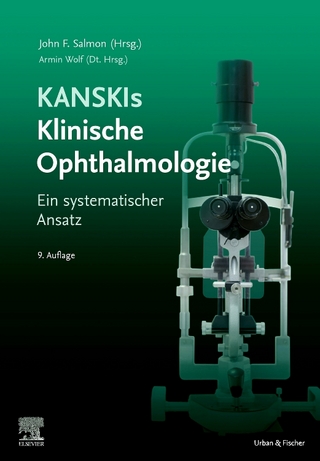
2020-2021 Basic and Clinical Science Course™ (BCSC), Section 04: Ophthalmic Pathology and Intraocular Tumors
Seiten
2020
American Academy of Ophthalmology (Verlag)
978-1-68104-360-9 (ISBN)
American Academy of Ophthalmology (Verlag)
978-1-68104-360-9 (ISBN)
Presents materials in two parts. Part I uses a hierarchy that moves from general to specific to help derive a differential diagnosis for a specific tissue. Part II is a compilation of selected clinical aspects of importance to the general ophthalmologist - this section contains extensive updates and discussion on intraocular tumors.
Major Revision
Section 4 presents materials in two parts: Part I, Ophthalmic Pathology; and Part II, Intraocular Tumors.
Part I uses a hierarchy that moves from general to specific to help derive a differential diagnosis for a specific tissue.
Part II is a compilation of selected clinical aspects of importance to the general ophthalmologist – this section contains extensive updates and discussion on intraocular tumors.
Now includes two interactive features that identify the disease process and cell type, expanded content on specimen handling, new photographs and illustrations throughout and key takeaways highlighted at the beginning of each chapter.
Additionally, this section has a variety of images and videos.
Upon completion of Section 4, readers should be able to:
- Use a hierarchical framework of topography, disease process, and differential diagnosis to understand major ocular conditions.
- Summarize the steps for handling ocular specimens for pathologic study.
- Explain the basic principles of special procedures and diagnostic testing used in ophthalmic pathology.
- State the main histologic features of common ocular conditions
- Identify those ophthalmic lesions that indicate systemic disease and are potentially life threatening
- Describe the methodologies used for intraocular tumor diagnosis; treatment modalities for ocular tumors; and important genetic information for families affected by retinoblastoma.
Major Revision
Section 4 presents materials in two parts: Part I, Ophthalmic Pathology; and Part II, Intraocular Tumors.
Part I uses a hierarchy that moves from general to specific to help derive a differential diagnosis for a specific tissue.
Part II is a compilation of selected clinical aspects of importance to the general ophthalmologist – this section contains extensive updates and discussion on intraocular tumors.
Now includes two interactive features that identify the disease process and cell type, expanded content on specimen handling, new photographs and illustrations throughout and key takeaways highlighted at the beginning of each chapter.
Additionally, this section has a variety of images and videos.
Upon completion of Section 4, readers should be able to:
- Use a hierarchical framework of topography, disease process, and differential diagnosis to understand major ocular conditions.
- Summarize the steps for handling ocular specimens for pathologic study.
- Explain the basic principles of special procedures and diagnostic testing used in ophthalmic pathology.
- State the main histologic features of common ocular conditions
- Identify those ophthalmic lesions that indicate systemic disease and are potentially life threatening
- Describe the methodologies used for intraocular tumor diagnosis; treatment modalities for ocular tumors; and important genetic information for families affected by retinoblastoma.
| Erscheinungsdatum | 02.07.2020 |
|---|---|
| Verlagsort | San Francisco |
| Sprache | englisch |
| Themenwelt | Medizin / Pharmazie ► Medizinische Fachgebiete ► Augenheilkunde |
| ISBN-10 | 1-68104-360-2 / 1681043602 |
| ISBN-13 | 978-1-68104-360-9 / 9781681043609 |
| Zustand | Neuware |
| Haben Sie eine Frage zum Produkt? |
Mehr entdecken
aus dem Bereich
aus dem Bereich
Ein systematischer Ansatz
Buch | Hardcover (2022)
Urban & Fischer in Elsevier (Verlag)
265,00 €


